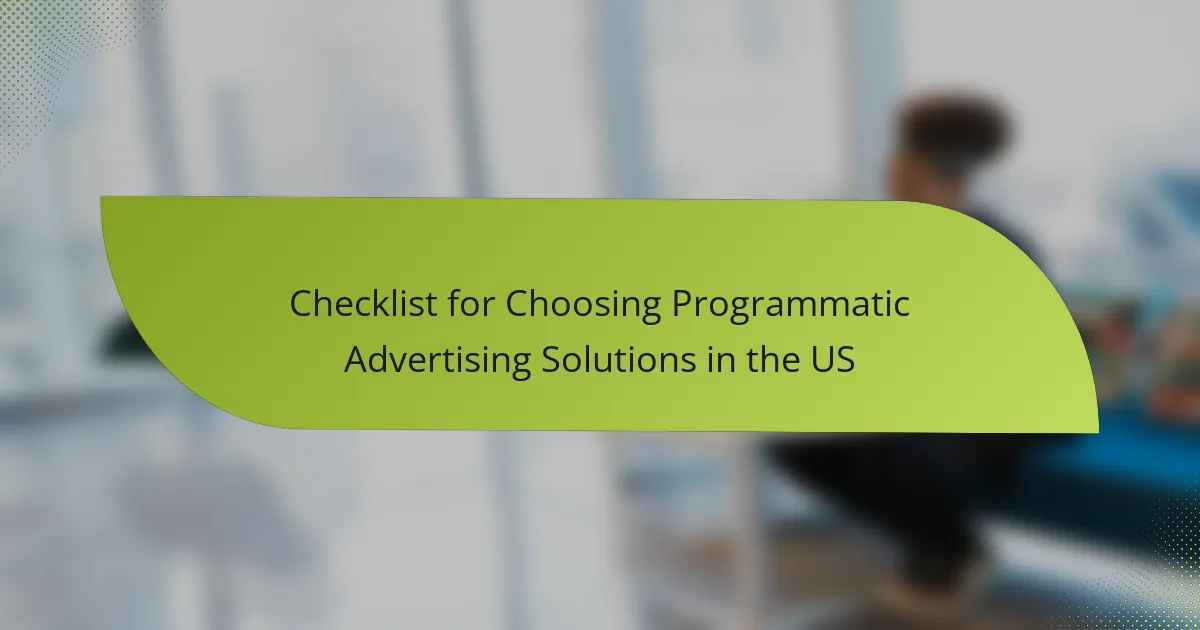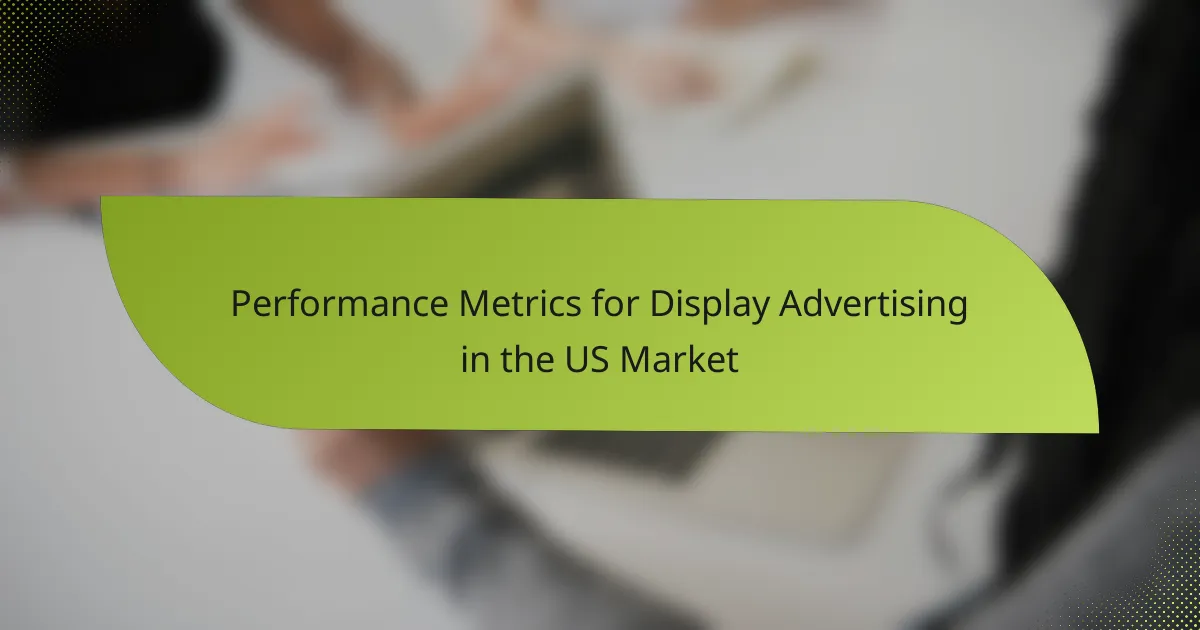Programmatic advertising spending in American industries is undergoing notable transformations, with significant increases in investment particularly in sectors like retail, healthcare, and mobile platforms. This trend reflects evolving consumer behaviors and advancements in technology, indicating a shift in how businesses approach advertising. Understanding the varying spending patterns across industries, such as automotive, financial services, and travel, is essential for optimizing advertising strategies in a competitive landscape.

What are the current trends in programmatic advertising spending across American industries?
Programmatic advertising spending in American industries is experiencing significant shifts, with notable increases in investment across various sectors. Retail, healthcare, and mobile platforms are leading the charge, reflecting changing consumer behaviors and technological advancements.
Increased investment in retail sector
The retail sector is seeing a marked rise in programmatic advertising spending as brands aim to reach consumers more effectively. This trend is largely driven by the shift towards online shopping, with retailers allocating a larger portion of their budgets to digital channels.
Retailers are leveraging data-driven strategies to target specific demographics and optimize their campaigns. For instance, personalized ads based on browsing history can lead to higher engagement rates and conversion, making programmatic a vital tool for retailers.
Growth in healthcare advertising
Healthcare advertising is increasingly adopting programmatic strategies to enhance outreach and patient engagement. This sector is focusing on targeted campaigns that address specific health needs and demographics, allowing for more effective communication.
With regulations like HIPAA in mind, healthcare advertisers are navigating compliance while utilizing programmatic platforms to deliver tailored messages. For example, campaigns promoting wellness programs can be directed towards specific age groups or health conditions, maximizing relevance and impact.
Shift towards mobile programmatic spending
There is a significant shift towards mobile programmatic spending as consumers increasingly access content through their smartphones. This trend reflects the growing importance of mobile-first strategies in reaching audiences where they spend most of their time.
Advertisers are focusing on mobile-optimized ads and utilizing location-based targeting to enhance engagement. For example, local businesses can use mobile programmatic to deliver ads to users within a specific radius, driving foot traffic and increasing sales opportunities.

How does programmatic advertising spending vary by industry in the US?
Programmatic advertising spending in the US varies significantly across industries, with some sectors investing heavily while others are just beginning to adopt this approach. The automotive, financial services, and travel industries showcase distinct spending patterns and growth trajectories.
Significant spending in automotive industry
The automotive industry is one of the largest spenders on programmatic advertising in the US, often allocating substantial budgets to digital campaigns. This sector leverages programmatic tools to target specific demographics and optimize ad placements in real time.
Brands in this industry typically focus on promoting new models, special offers, and dealership events. With the rise of electric vehicles, automakers are increasingly using programmatic ads to reach environmentally conscious consumers.
High growth rates in financial services
Financial services are experiencing high growth rates in programmatic advertising spending, as companies seek to engage a tech-savvy audience. This sector uses data-driven strategies to deliver personalized messages about banking, insurance, and investment products.
Financial institutions are particularly focused on compliance and security in their advertising efforts, ensuring that they adhere to regulations while effectively reaching potential clients. The adoption of programmatic advertising allows these companies to refine their targeting and improve ROI.
Emerging trends in travel and hospitality
The travel and hospitality industry is witnessing emerging trends in programmatic advertising, particularly as consumer behavior shifts post-pandemic. Companies are utilizing programmatic strategies to promote travel deals, accommodations, and experiences to a more discerning audience.
As travelers increasingly seek personalized options, programmatic advertising enables brands to tailor their messages based on user preferences and behaviors. This sector is also exploring innovative formats, such as video ads and interactive content, to enhance engagement and drive bookings.

What factors are driving changes in programmatic advertising budgets?
Changes in programmatic advertising budgets are primarily influenced by shifts in consumer behavior, advancements in advertising technology, and varying economic conditions. Understanding these factors can help businesses allocate their budgets more effectively and optimize their advertising strategies.
Consumer behavior shifts
Consumer behavior is evolving rapidly, with increased reliance on digital platforms for shopping and information. This shift has prompted advertisers to allocate more funds to programmatic advertising, which allows for targeted and personalized ad placements based on user data.
For example, as more consumers engage with mobile devices and social media, businesses are investing in programmatic ads that reach these audiences in real-time. Advertisers must continuously analyze consumer trends to adjust their budgets accordingly and maximize engagement.
Technological advancements in ad tech
Advancements in advertising technology are reshaping how programmatic advertising budgets are spent. Innovations such as artificial intelligence and machine learning enable more precise targeting and optimization of ad campaigns, leading to higher return on investment.
Tools that automate bidding and optimize ad placements based on performance metrics allow advertisers to allocate their budgets more efficiently. Companies should stay updated on the latest ad tech developments to leverage these tools effectively and enhance their advertising strategies.
Impact of economic conditions
Economic conditions significantly influence programmatic advertising budgets, as businesses often adjust spending based on market stability and consumer spending power. During economic downturns, companies may reduce their advertising budgets, while in a thriving economy, they might increase spending to capture more market share.
For instance, during periods of inflation, businesses may prioritize cost-effective advertising channels like programmatic ads, which can offer better targeting and lower costs compared to traditional media. Monitoring economic indicators can help advertisers anticipate budget changes and adapt their strategies accordingly.

How do American companies allocate their programmatic advertising budgets?
American companies typically allocate their programmatic advertising budgets based on performance metrics, audience targeting, and platform effectiveness. The distribution varies significantly across industries, reflecting differing marketing strategies and objectives.
Percentage of budget spent on display ads
Display ads account for a substantial portion of programmatic advertising budgets, often ranging from 30% to 50% depending on the industry. Companies prioritize display ads for their visual impact and ability to reach a broad audience.
For instance, retail and e-commerce sectors frequently invest heavily in display advertising to showcase products and promotions. In contrast, sectors like finance may allocate a smaller percentage, focusing instead on more targeted strategies.
Investment in data-driven strategies
Investment in data-driven strategies is crucial for optimizing programmatic advertising efforts. Many American companies allocate around 20% to 40% of their budgets to data analytics tools and platforms that enhance targeting and measurement.
Utilizing data allows businesses to refine their audience segments and improve ad placements, leading to better return on investment (ROI). Companies should consider integrating customer data platforms (CDPs) to streamline their data-driven approaches.
Allocation towards video programmatic ads
Video programmatic ads are increasingly popular, with many companies dedicating 25% to 35% of their programmatic budgets to this format. Video ads offer higher engagement rates and are effective for storytelling, making them attractive for brand awareness campaigns.
Industries such as entertainment and consumer goods often lead in video ad spending, leveraging platforms like YouTube and social media. Companies should experiment with various video lengths and formats to determine what resonates best with their target audience.

What are the challenges faced by industries in programmatic advertising?
Industries face several challenges in programmatic advertising, including navigating data privacy regulations and combating ad fraud. These issues can significantly impact the effectiveness and trustworthiness of advertising campaigns.
Data privacy regulations
Data privacy regulations, such as the GDPR in Europe and CCPA in California, impose strict guidelines on how companies collect and use consumer data. These laws require businesses to obtain explicit consent before tracking user behavior, which can limit the effectiveness of targeted advertising.
To comply with these regulations, industries must implement transparent data collection practices and ensure that users are informed about their data usage. This may involve updating privacy policies and investing in consent management platforms to handle user preferences effectively.
Ad fraud concerns
Ad fraud is a significant concern in programmatic advertising, with estimates suggesting that billions of dollars are lost annually due to fraudulent activities. Common types of ad fraud include click fraud, where bots generate false clicks, and impression fraud, where ads are displayed on non-human traffic sites.
To mitigate ad fraud, industries should employ verification tools and work with reputable ad networks that prioritize transparency. Regular audits and monitoring of campaign performance can help identify suspicious activity and protect advertising budgets.



